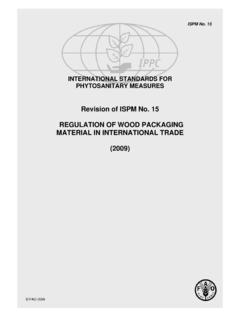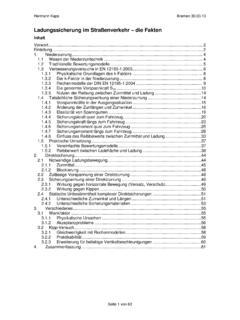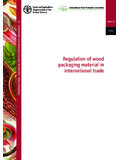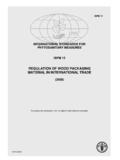Transcription of Revision of ISPM No. 15 REGULATION OF WOOD …
1 ISPM No. 15. international STANDARDS FOR. PHYTOSANITARY MEASURES. Revision of ISPM No. 15. REGULATION OF WOOD packaging . material IN international trade . (2009). FAO 2009. REGULATION of wood packaging material in international trade ISPM No. 15. CONTENTS. INTRODUCTION. SCOPE. ENVIRONMENTAL STATEMENT. REFERENCES. DEFINITIONS. OUTLINE OF REQUIREMENTS. REQUIREMENTS. 1. Basis for REGULATION 2. Regulated Wood packaging material Exemptions 3. Phytosanitary Measures for Wood packaging material Approved phytosanitary measures Approval of new or revised treatments Alternative bilateral arrangements 4. Responsibilities of NPPOs Regulatory considerations Application and use of the mark Treatment and marking requirements for wood packaging material that is reused, repaired or remanufactured Reuse of wood packaging material Repaired wood packaging material Remanufactured wood packaging material Transit Procedures upon import Phytosanitary measures for non-compliance at point of entry ANNEX 1.
2 Approved treatments associated with wood packaging material ANNEX 2. The mark and its application APPENDIX 1. Examples of methods of secure disposal of non-compliant wood packaging material international Standards for Phytosanitary Measures 3. REGULATION of wood packaging material in international trade ISPM No. 15. INTRODUCTION. SCOPE. This standard describes phytosanitary measures that reduce the risk of introduction and spread of quarantine pests associated with the movement in international trade of wood packaging material made from raw wood. Wood packaging material covered by this standard includes dunnage but excludes wood packaging made from wood processed in such a way that it is free from pests ( plywood).
3 The phytosanitary measures described in this standard are not intended to provide ongoing protection from contaminating pests or other organisms. ENVIRONMENTAL STATEMENT. Pests associated with wood packaging material are known to have negative impacts on forest health and biodiversity. Implementation of this standard is considered to reduce significantly the spread of pests and subsequently their negative impacts. In the absence of alternative treatments being available for certain situations or to all countries, or the availability of other appropriate packaging materials, methyl bromide treatment is included in this standard. Methyl bromide is known to deplete the ozone layer. A CPM. Recommendation on the Replacement or reduction of the use of methyl bromide as a phytosanitary measure (2008) has been adopted in relation to this issue.
4 Alternative treatments that are more environmentally friendly are being pursued. REFERENCES. Consignments in transit, 2006. ISPM No. 25, FAO, Rome. Export certification system, 1997. ISPM No. 7, FAO, Rome. Glossary of phytosanitary terms, 2008. ISPM No. 5, FAO, Rome. Guidelines for a phytosanitary import regulatory system, 2004. ISPM No. 20, FAO, Rome. Guidelines for inspection, 2005. ISPM No. 23, FAO, Rome. Guidelines on notification of non-compliance and emergency action, 2001. ISPM No. 13, FAO, Rome. ISO 3166-1-alpha-2 code elements ( ). international Plant Protection Convention, 1997. FAO, Rome. Phytosanitary treatments for regulated pests, 2007. ISPM No. 28, FAO, Rome. Replacement or reduction of the use of methyl bromide as a phytosanitary measure, 2008.
5 CPM. Recommendation, FAO, Rome. The Montreal Protocol on Substances that Deplete the Ozone Layer, 2000. Ozone Secretariat, United Nations Environment Programme. ISBN: 92-807-1888-6 ( ). DEFINITIONS. Definitions of phytosanitary terms used in this standard can be found in ISPM No. 5 (Glossary of phytosanitary terms, 2008). OUTLINE OF REQUIREMENTS. Approved phytosanitary measures that significantly reduce the risk of pest introduction and spread via wood packaging material consist of the use of debarked wood (with a specified tolerance for remaining bark) and the application of approved treatments (as prescribed in Annex 1). The application of the recognized mark (as prescribed in Annex 2) ensures that wood packaging material subjected to the approved treatments is readily identifiable.
6 The approved treatments, the mark and its use are described. The National Plant Protection Organizations (NPPOs) of exporting and importing countries have specific responsibilities. Treatment and application of the mark must always be under the authority of the NPPO. NPPOs that authorize the use of the mark should supervise (or, as a minimum, audit or review) the application of the treatments, use of the mark and its application, as appropriate, by producer/treatment providers and should establish inspection or monitoring and auditing procedures. Specific requirements apply to wood packaging material that is repaired or remanufactured. NPPOs of importing countries should accept the approved phytosanitary measures as the basis for authorizing entry of wood packaging material without further wood packaging material -related phytosanitary import requirements and may verify on import that the requirements of the standard have been met.
7 Where wood packaging material does not international Standards for Phytosanitary Measures 5. ISPM No. 15 REGULATION of wood packaging material in international trade comply with the requirements of this standard, NPPOs are also responsible for measures implemented and notification of non-compliance, as appropriate. 6 international Standards for Phytosanitary Measures REGULATION of wood packaging material in international trade ISPM No. 15. REQUIREMENTS. 1. Basis for REGULATION Wood originating from living or dead trees may be infested by pests. Wood packaging material is frequently made of raw wood that may not have undergone sufficient processing or treatment to remove or kill pests and therefore remains a pathway for the introduction and spread of quarantine pests.
8 Dunnage in particular has been shown to present a high risk of introduction and spread of quarantine pests. Furthermore, wood packaging material is very often reused, repaired or remanufactured (as described in section ). The true origin of any piece of wood packaging material is difficult to determine, and thus its phytosanitary status cannot easily be ascertained. Therefore the normal process of undertaking pest risk analysis to determine if measures are necessary, and the strength of such measures, is frequently not possible for wood packaging material . For this reason, this standard describes internationally accepted measures that may be applied to wood packaging material by all countries to reduce significantly the risk of introduction and spread of most quarantine pests that may be associated with that material .
9 2. Regulated Wood packaging material These guidelines cover all forms of wood packaging material that may serve as a pathway for pests posing a pest risk mainly to living trees. They cover wood packaging material such as crates, boxes, packing cases, dunnage 1 , pallets, cable drums and spools/reels, which can be present in almost any imported consignment, including consignments that would not normally be subject to phytosanitary inspection. Exemptions The following articles are of sufficiently low risk to be exempted from the provisions of this standard 2 : - wood packaging material made entirely from thin wood (6 mm or less in thickness). - wood packaging made wholly of processed wood material , such as plywood, particle board, oriented strand board or veneer that has been created using glue, heat or pressure, or a combination thereof - barrels for wine and spirit that have been heated during manufacture - gift boxes for wine, cigars and other commodities made from wood that has been processed and/or manufactured in a way that renders it free of pests - sawdust, wood shavings and wood wool - wood components permanently attached to freight vehicles and containers.
10 3. Phytosanitary Measures for Wood packaging material This standard describes phytosanitary measures (including treatments) that have been approved for wood packaging material and provides for the approval of new or revised treatments. Approved phytosanitary measures The approved phytosanitary measures described in this standard consist of phytosanitary procedures including treatments and marking of the wood packaging material . The application of the mark renders the use of a phytosanitary certificate unnecessary as it indicates that the internationally accepted phytosanitary measures have been applied. These phytosanitary measures should be accepted by all National Plant Protection Organizations (NPPOs) as the basis for authorizing the entry of wood packaging material without further specific requirements.




